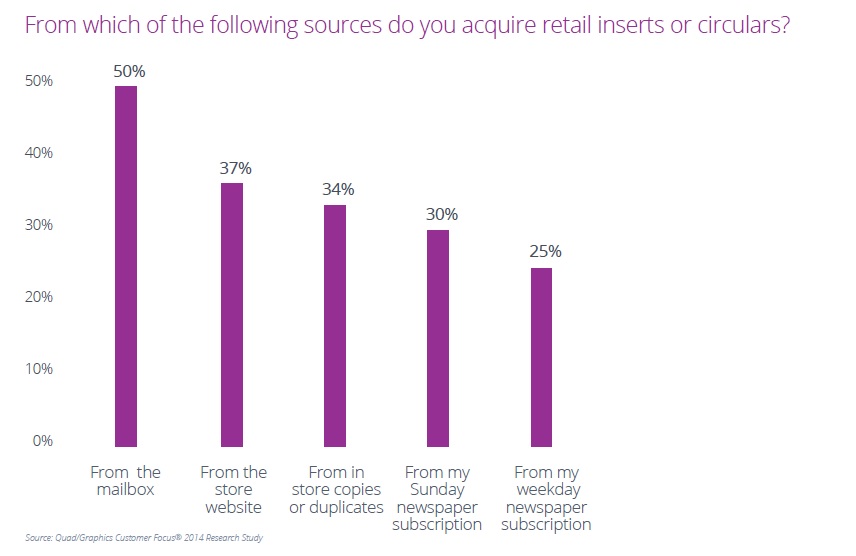WHY IS IT ... EVERYONE THINKS THE PRINT INSERT IS DEAD...WHEN IT MOST CERTAINLY IS NOT!
Print Ain’t Dead Yet - Direct Mail Outperforms Digital Channels by 600%
The Direct Marketing Association recently reported that direct mail’s response rate surpasses that of all digital channels — by a long shot.
According to their research, direct mail achieves a 3.7% response rate with a house list, and a 1% response rate with a prospect list.
Read the original article HERE
According to their research, direct mail achieves a 3.7% response rate with a house list, and a 1% response rate with a prospect list.
Read the original article HERE
Direct mail achieves a 3.7% response rate with a house list, and a 1% response rate with a prospect list.
Direct Marketing isn't relegated to just a solo-mailed postcard or a letter, it's ANYTHING delivered to the mailbox including inserts
But it gets even better: Mobile, paid search, social media, email, and internet display combined (yes, combined) only achieve a .62% response rate. Put another way, print outperforms all digital channels combined by over 600%.
But the study also states fewer companies are using DIRECT marketing, even though the response rates have climbed in the last 2 years
there is less competition in the mailbox for your prospects’ attention, your message may get more easily in front of your prospect?
Three fundamentals still exist across all platforms, no matter what your marketing strategy is:
There are three reasons I'm writing this blog about print:
First, I get inundated daily by digital marketers stating they can do this, that and everything else to get leads and sales. It's getting as bad as those emails from Nigeria that I have 14 Gazillion dollars waiting for me to claim, or that XYZ company can get me to page one on Google.
There is no question the "Path to Purchase" has become very complicated and that digital marketing "works" and the costs/investments are in reach of most brands and retailers. But to ignore other marketing delivery mediums is foolish and I will show you why, below with research I've uncovered.
Second, Most Millennials ignore digital ads....more proof that you need an integrated strategy.
- Frequency
- Consistency
- Reach
There are three reasons I'm writing this blog about print:
First, I get inundated daily by digital marketers stating they can do this, that and everything else to get leads and sales. It's getting as bad as those emails from Nigeria that I have 14 Gazillion dollars waiting for me to claim, or that XYZ company can get me to page one on Google.
There is no question the "Path to Purchase" has become very complicated and that digital marketing "works" and the costs/investments are in reach of most brands and retailers. But to ignore other marketing delivery mediums is foolish and I will show you why, below with research I've uncovered.
Second, Most Millennials ignore digital ads....more proof that you need an integrated strategy.
millennials don't LIKE DIGITAL ads:
Read more
U.S. adult consumers who had used newspaper inserts, or FSI's - Free Standing Inserts -cited deal-related benefits. Fully 70% said they checked the inserts to find out about sales and savings, while 62% said the fliers saved them time and money—and 56% had clipped coupons from a newspaper insert in the 30 days prior to polling.
Interestingly, a majority of respondents enjoyed looking through newspaper inserts just because; with 57% browsing even when not in the market for an item and 56% doing so simply because it was a part of their routine. - See more at: http://tinyurl.com/gt6xtx5
Interestingly, a majority of respondents enjoyed looking through newspaper inserts just because; with 57% browsing even when not in the market for an item and 56% doing so simply because it was a part of their routine. - See more at: http://tinyurl.com/gt6xtx5
BUT THE PROOF THAT INSERTS DO WORK, DOESN'T END THERE.
CONSIDER THIS RESEARCH:
Two-thirds of newspaper readers either always or regularly look at inserts, according to Coda Ventures' Triad research, a Nashville-based research firm specializing in newspaper research. Coda Ventures recently reported that fewer than nine percent of newspapers readers state that they "seldom or never" look at inserts.
And, most important to advertisers, newspaper inserts drive action.
Nine out of ten newspaper readers report that they take one or more of a broad range of specific actions after reading or looking at inserts.
Other recent research by Research and Analysis of Media (RAM), an international media research company, confirms the crucial role newspaper inserts play in consumer marketing. Data shows that nearly nine in 10 of media consumers use newspaper inserts. This is much higher than the usage of direct mailers.
And, most important to advertisers, newspaper inserts drive action.
Nine out of ten newspaper readers report that they take one or more of a broad range of specific actions after reading or looking at inserts.
Other recent research by Research and Analysis of Media (RAM), an international media research company, confirms the crucial role newspaper inserts play in consumer marketing. Data shows that nearly nine in 10 of media consumers use newspaper inserts. This is much higher than the usage of direct mailers.
I could literally bore you to death with statistics and research; So I spent the weekend doing that for you and pulled out the most relevant, for this quick read.
When I contacted Valassis for their information about my article, the two charts below they sent me below really stood out:
When I contacted Valassis for their information about my article, the two charts below they sent me below really stood out:
BUT, I am NOT extolling using newspapers as your primary delivery vehicle. Subscription rates to newspapers are dying a slow death, except the Sunday editions where people look for your inserted promotions.
In some of the larger markets, subscriptions may still be relevant; however, in most markets, I suggest you use delivery vehicles like the Valassis Red Plum, delivered in the mailbox, if it's not delivered in your local paper. AND don't just rely on a "print-only strategy"; you have to integrate your promotional print program with digital too, because:
In some of the larger markets, subscriptions may still be relevant; however, in most markets, I suggest you use delivery vehicles like the Valassis Red Plum, delivered in the mailbox, if it's not delivered in your local paper. AND don't just rely on a "print-only strategy"; you have to integrate your promotional print program with digital too, because:
|
A survey conducted by Valassis found that within 30 days of viewing a newspaper inserts, 30% of people went online to get more information. Just one of many reasons you MUST have a robust website with tons of content for consumers to shop.
+ |
Additionally, in the Wall Street Journal, they also substantiated "
the good news that newspaper inserts drove more retail shoppers than digital ads and are, without a doubt, the most powerful drive-to-retail media available to marketers".
So, how do you get started to take advantage of a fully integrated selling strategy with this information?Step One- Only work with a company that knows this industry, unless you do it all in-house.
Work only with a company that specializes in the furniture category for your creative design, print and distribution for your print program. I recommend Imagine Advertising. They've been doing this for over 15 years and have dropped over a billion...yes with a "B", print inserts for thousands of retailers. And they have a contract with Valassis, too, which is critical so that you get the best rate available. Be sure to have a call to action, a coupon offer or something that you can track your promotion's effectiveness, AND be sure that this call to action is done digitally with integration on mobile and on your website. Using geography-based targeting is key to increase your ROI, delivering relevant, localized messages to high-opportunity consumers via desktop, mobile or tablet. Yep, you've just about covered every marketing medium that is relevant today. AND...don't forget Direct Mail in the mix: |
While pairing direct mail with email is effective, pairing direct mail with mobile devices provides more opportunities to interact with the customer. In 2014, direct mail influenced “76% of internet users to buy a product or service online” (Gould). Also in 2014, it was found that “34% of customers search online about a product or service when receiving direct mail from a brand they are interested in” (Gould).
Step Two - Create a budget.
Typical advertising budgets retailers should be looking at are between 5%-10% of sales. Be sure you take into consideration the key home furnishing shopping dates in the fall, spring, summer and winter so you get maximum engagement.
The average cost just for the print portion runs between $.08-$.10/each as a delivered price, which should include everything: design, print, and distribution for the printed insert. But there are a variety of options to consider: Red Plum wrap, ROP ads, solo mail options and more, and this is why you need to deal with a company like Imagine Advertising. They know all of the available options and can recommend the best platform based off your store's profile and budget.
Step Three - Know your target audience.
Have a target market profile created by Valassis for your retail location(s). This will highlight the areas you should be focused on based off your store's information. This will include zip codes, income levels, market indices - propensity to buy, and more, so you can develop a "plan."
I suggest you test different offers to different demographics in your area. If you're targeting Boomers, you may want to focus on mattresses, recliners and other products your CRM/POS software shows are most likely to engage that demographic. The same with younger Millennials, maybe beds/bedrooms...that's the first item people buy when they move out of Mom & Dad’s, apartment living, etc. Again, pull your data and marry it up with the data provided by Imagine & Valassis.
Step Four - Track Everything.
Don't assume anything. Ask consumers how they heard of you, what brought them to the store, website visits before and after the promotion drops, what they bought vs. what was promoted and more.
You need to gauge effectiveness, so start with the basics and wok with your CRM/POS programs to fine-tune this strategy.
Step Five - Analyze, fine-tune and REPEAT at least monthly - Bi-monthly if you're in a competitive market.
Knowledge is power and information creates knowledge. Fine-tune what you know and then put it to good use by repeating this process over and over.
Step Two - Create a budget.
Typical advertising budgets retailers should be looking at are between 5%-10% of sales. Be sure you take into consideration the key home furnishing shopping dates in the fall, spring, summer and winter so you get maximum engagement.
The average cost just for the print portion runs between $.08-$.10/each as a delivered price, which should include everything: design, print, and distribution for the printed insert. But there are a variety of options to consider: Red Plum wrap, ROP ads, solo mail options and more, and this is why you need to deal with a company like Imagine Advertising. They know all of the available options and can recommend the best platform based off your store's profile and budget.
Step Three - Know your target audience.
Have a target market profile created by Valassis for your retail location(s). This will highlight the areas you should be focused on based off your store's information. This will include zip codes, income levels, market indices - propensity to buy, and more, so you can develop a "plan."
I suggest you test different offers to different demographics in your area. If you're targeting Boomers, you may want to focus on mattresses, recliners and other products your CRM/POS software shows are most likely to engage that demographic. The same with younger Millennials, maybe beds/bedrooms...that's the first item people buy when they move out of Mom & Dad’s, apartment living, etc. Again, pull your data and marry it up with the data provided by Imagine & Valassis.
Step Four - Track Everything.
Don't assume anything. Ask consumers how they heard of you, what brought them to the store, website visits before and after the promotion drops, what they bought vs. what was promoted and more.
You need to gauge effectiveness, so start with the basics and wok with your CRM/POS programs to fine-tune this strategy.
Step Five - Analyze, fine-tune and REPEAT at least monthly - Bi-monthly if you're in a competitive market.
Knowledge is power and information creates knowledge. Fine-tune what you know and then put it to good use by repeating this process over and over.
REMEMBER, "Water dripping on a stone leaves a mark."
and there is more ... much more you need to know
the power of point of sale in your storeIn-store advertising was present for 37.8% of products purchased.
|
the myth of digital marketing uncoveredPeople DO NOT like your digital ads
|
MARKETING TO MILLENNIALS - THE MYTH DISSECTEDOver 31% live at home - Average credit score of 640
|
AND WE CAN HELP YOUR RETAIL STORE OR BRAND WITH OUR FREE BUSINESS MARKETING ANALYSIS
NO STRINGS ATTACHED - NO SALES PITCH
WE'LL DISCUSS YOUR
Website & Web Presence • Social & Digital Marketing Platforms • Brand Management • Retail Strategy • Your Marketing, Advertising & Promotion Strategies & Tactics • Marketing Communications
Or any other discussion item you want to address.
Website & Web Presence • Social & Digital Marketing Platforms • Brand Management • Retail Strategy • Your Marketing, Advertising & Promotion Strategies & Tactics • Marketing Communications
Or any other discussion item you want to address.
















